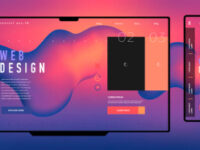What Is Website Design?
 Website design is the overall look and feel of a website. It involves the layout, colors, graphics, and content.
Website design is the overall look and feel of a website. It involves the layout, colors, graphics, and content.
A well-designed website should be visually appealing and easy to navigate. It should also have fast loading times. This will help to keep visitors interested and loyal. The site should also speak directly to the target audience. Visit Website to learn more.
Content is the main part of any website. It’s what wins your customers’ wallets and sets you apart from your competitors. Great design helps support and deliver it, but it can’t sell on its own. The best way to ensure that your website delivers the right message is through proper market research. This includes identifying your high-value customers and developing targeted personas. Then, you can build a website that speaks to them in the most effective way possible.
A website consists of one or more web pages, which are digital documents written in HTML(HyperText Markup Language). Websites are hosted on computers that connect to the Internet round the clock. The web pages are connected with hyperlinks. Websites offer a wide range of services, including information, entertainment and commerce. They also provide a means of communication and collaboration.
Most websites have a home page that introduces the company and its products or services. The home page contains important links to other pages of the site and is a key element of website design. Other pages may have more in-depth information. For example, a product page might list the features and prices of a particular product. Other pages might explain all the different services a company offers, like this service page by educator, author and speaker Monique Melton.
A website can also contain a blog, which is a series of posts about a particular topic. Each post has a title and includes text, photos, and other elements. Some blogs are written by individuals, and others by organizations.
The layout of a website is important because it reveals how the designer intends the viewer to experience the content. Using visual hierarchy, the layout can draw attention to key pieces of information and encourage the visitor to click or scroll down for more. Designers can create a layout using several tools, including HTML for content and structure, cascading style sheets for formatting presentation details and JavaScript for interactivity.
The grid system is a classic layout that combines a mathematical sense of order with a flexible design. It allows designers to arrange a lot of information in a small space without sacrificing clarity or readability. It is also a good way to create a cohesive look for a site, especially one with multiple pages.
A full-screen image is a popular option for websites that are looking to communicate their message in a powerful and compelling way. It is recommended to use high-quality images that are optimized for desktop and mobile platforms. These images should be accompanied by a brief description that introduces the company or service and encourages visitors to explore more.
An asymmetrical layout features two sides of the website that are not equal in size, weight or color. This gives certain elements a greater prominence, and can increase the overall impression of movement and energy. This is a good option for websites that are looking to convey dynamic and innovative information, such as a business or design agency website.
Website graphics are the visual representations that are used in a website to convey any information, emotion or idea to the visitors. They are an important tool of website design as it helps in attracting the visitor’s attention and also plays a vital role in branding. They can include photos, maps, family trees, designs, patterns, cartoons and diagrams etc. These elements must be carefully chosen so that they are able to add value to the website and attract the visitors’ attention. They should be created by keeping in mind the customer psychology. They must be artistically competent and should be consistent with the website theme.
They can be easily used in a website to improve its aesthetic appeal and make it more user friendly. They can also help in creating a more structured site, by breaking down large amounts of text into more manageable sections. For example, a restaurant website can use photos of dishes or haircuts to show what their customers can expect. These images can help to maintain the audience’s interest in a long piece of text and may even amplify the tone of a written story.
Graphics should be used sparingly, however, as they can become a distraction if they aren’t relevant to the content of a page. Strong graphics can draw attention away from the text and compete with one another on the page, which can lead to an overly busy or confusing website.
A web design’s colors are an important aspect of the website’s aesthetic and user experience. They can evoke specific emotions in the visitor and make them respond to certain call-to-actions on the site. A good web designer knows how to use colors to create a sense of depth and movement in the site’s content.
Colors are categorized as either complementary, analogous, or neutral. Complementary colors are opposite each other on the color wheel and provide a great deal of contrast. They work well for elements like buttons and navigation menus because they draw attention. The color orange, for example, is a strong call-to-action color and can be found on many websites.
Analogous colors are adjacent to each other on the color wheel and also work well for websites. They help to give the website a more uniform look and feel. They are also popular for logos and fonts because they match well with other colors.
Neutral colors are those that don’t create a lot of emotion and work best for sites that have a lot of text or graphs. They are also used for backgrounds because they are easy on the eyes.
It’s important to understand the meanings of each color when designing a website. This will help you to choose a palette that suits your business and will be effective in generating the desired reaction from visitors. For example, yellow can be fun and energetic in small doses but may become abrasive or overwhelming in large quantities.
Website styles are the specific details that determine how a website will look. This includes elements like fonts, colors, icons, layouts, and other visual elements. Having a well-defined style guide helps ensure consistency across pages and elements. It also helps reduce maintenance costs by allowing web professionals to change styles easily without editing every single page.
For example, a designer might include rules regarding fonts and font sizes. They may also include rules for whether or not to use icons and how many different icon styles are allowed. Including these rules prevents developers from using a font size that is too small and causes the text to appear illegible. It also prevents them from using a color that is too dark and causes the content to be hard to read.
Another important aspect of web design is layout and grids. A designer might want to include a grid or layout that is based on graphic design principles, such as the rule of thirds. This principle suggests dividing an image into three equal parts horizontally and vertically, with the points of intersection being key areas of focus. This can make a site more visually appealing and balanced.
Another way to create a website style is to include a CSS file that defines the default layout and style of all pages. This will help ensure that all pages are developed in valid XHTML and CSS, and that they will have the same appearance in different browsers. This is important because it allows users to navigate the site easily, and it will allow designers to keep the code clean and simple.
The usability of a website is an essential element in web design. It determines how easily users can interact with the site and whether it meets their expectations and goals. There are a number of ways to improve the usability of a website, including conducting user research, making the content as clear and accessible as possible, and providing feedback to users.
In the past, website usability was not considered as an important factor in SEO (search engine optimization). However, recent updates to Google’s ranking algorithm have put a greater emphasis on the quality of a website. In addition, improved website usability can also increase customer satisfaction and boost a business’s reputation.
According to the renowned usability expert Jakob Nielsen, a website’s usability can be measured in five components: learnability, efficiency, memory, and satisfaction. The simplest way to measure website usability is to ask representatives of your target market to use the site and observe what they do.
Some examples of poor website usability include intrusive banners that block users’ access to the content, pop-up windows asking them to subscribe to news or join an online consultant, and redundant animation on websites that aren’t optimized for older devices. While these elements might seem minor, they can greatly affect the overall usability of a website and lead to users leaving forever. A satisfied client is one of the best forms of advertisement a business can have, so ensuring your website’s usability is key to gaining and keeping customers.




